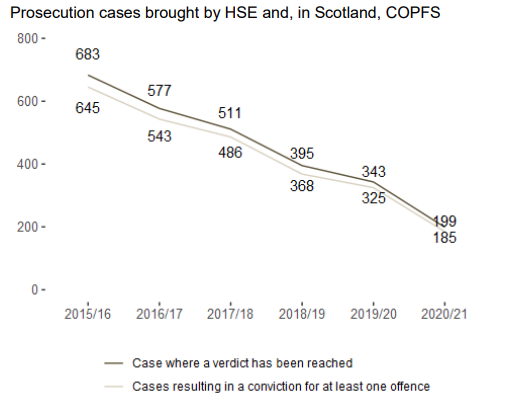The Numbers
In 2020/2021 199 cases were prosecuted by the HSE compared to 325 in 2019/2020 representing a notable 42% decrease on the previous year. The number of workers killed at work in 2020/2021 was 142 up from 111 the previous year.
The HSE's summary graph reveals the continuing downward trend in prosecutions brought by the HSE in England, Wales and Scotland:

Not only are prosecutions brought by the HSE at an all-time low but the number of enforcement notices issued have also dropped considerably from 7,075 in 2019/2020 to only 2,929 in 2020/21 representing a 58% decrease from the previous year.
Whilst the numbers on the face of it appear to suggest that the HSE have taken their foot off the gas when it comes to general enforcement action, the conviction rate when a prosecution is brought remains extremely high when compared to other criminal cases. Out of the 199 cases prosecuted in 2020/2021 the HSE secured a conviction on at least one of the offences charged in 185 of them representing a conviction rate of 93% compared to the general criminal conviction rate of 83.6% .This shows that the conviction rate in health and safety related cases has remained steady between 93% and 95% between 2015/2016 and 2020/2021.
However, the statistics do reveal that the Courts are continuing to adopt an uncompromising approach to those who come before them. Whilst the total fines figure has dropped to £26.9 million in 2020/2021 from £34.9 million in 2019/2020 due to the drop in the number of prosecutions, the average fine has increased from £107,000 to £145,000 in same period representing a considerable increase of 35%. There were also seven cases sentenced in 2020/2021 where an organisation received a fine of £1 million or more. To compare, the average fine has increased from an average of £54,000 per conviction in 2014/2015. From this we can see that fines for health and safety offences remain at an all-time high since the introduction of the Health and Safety Guidelines in 2016 and Judges appear to be getting more comfortable handing out serious fines intended to have a significant economic impact on the organisations on which they are imposed.
The caveats and looking forward
The statistics only give us a snapshot of the cases where a verdict was reached in 2020/2021 and we all know that those years were not normal years for anyone. With massive court backlogs for all cases, but particularly health and safety cases, there is a large backlog of health and safety cases to be heard in the coming years. The HSE have also noted in the statistics that the data in 2020/2021 relates only to the HSE and not local authorities due to the COVID pandemic and the related issues with the collection of data which may make the figures look artificially low.
The HSE have previously sought to explain the fall in the number of prosecutions for various reasons, for example in 2018/2019 the lack of qualified inspectors and an increase in time-consuming legal hearings were cited as reasons to explain the decrease because they had a larger than normal number of inspectors in training and litigation was being drawn out. But how does that explain the continuing fall in prosecutions?
Of course, the COVID pandemic will be one reason and HSE Inspectors will undoubtedly have had to adapt and take a flexible approach to ongoing regulation. We will need to wait and see how this will impact the statistics next year but it is likely that we will see some increase in the number of prosecutions brought. However, COVID can only explain so much as the statistics show that prosecutions and enforcement notices have been steadily declining for a number of years now. The exasperated court delays will likely be another reason for the decline in prosecutions but Inspectors may also be concentrating on the most serious breaches. Since the introduction of Notice of Contravention and the Fees for Intervention Scheme the HSE may simply have less appetite to prosecute when they can bring about change through the issuing of a Notice of Contravention and claim their investigation costs for doing so and avoiding the time consuming and complicated courts system altogether.
Nonetheless, with conviction rates and average fines remaining extremely high businesses cannot disregard their health and safety obligations on the basis that they are now statistically less likely to be prosecuted. The HSE's enforcement policy and decision-making principles have not changed and where there has been a fatality, the HSE's enforcement management model still makes a prosecution as the starting point. The statistics also show that the impact of a conviction for a health and safety offence still remains very serious as there will still be huge reputational, financial and commercial ramifications for businesses.
You can find all of the HSE's enforcement statistics for 2020/2021 here.














